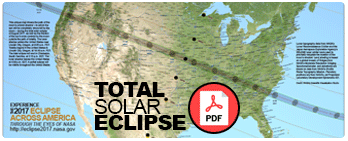WHAT’S UP? Lunar Libration
By Lou Mayo
The earliest records we have that anyone paid attention to solar eclipses are from Irish Neolithic astronomers who recorded in stone, the eclipse of November 30, 3340 BCE at what is now the Loughcrew Cairn L Megalithic Monument in Ireland. Solar eclipses must have been frightening events and we know from numerous writings that they were often viewed as bad omens. Today, people can view total solar eclipses without fear and fairly easily as long as you are prepared to travel a bit. But this will not always be the case. Here’s why.
The moon moves around the Earth in an elliptical orbit. So, sometimes it is closer to Earth and sometimes farther. When it is near its furthest distance (called apogee), it appears too small in the sky to completely cover the sun. When this happens during a solar eclipse, the moon can cover only a portion of the sun and a bright “ring of fire” is seen around the edge of the moon. There are already points in the moon’s orbit where a total solar eclipse cannot occur.
The moon orbits the Earth once every 27.3 days (sidereal orbital period). The Earth, spinning on its axis once in only one day, pulls on the moon, urging it to go faster, like playing crack the whip on an ice rink. In order to conserve energy – a basic law of physics, called conservation of angular momentum, the moon must also move further out in its orbit, further away from Earth. Effectively, the moon is stealing some of the Earth’s rotational energy so as the moon speeds up, the Earth slows down (a little). In fact, this energy “sharing” has been going on for a long time and our day has been getting longer for a long time. Four billion years ago, the day was only about seven hours long!
It turns out that this increase in the moon’s orbital energy moves it away from Earth at a rate of about 3.8 cm per year. We know this because we can fire a pulse of laser light at the corner cubic laser reflectors left on the moon by the Apollo missions and time its return. 3.8cm per year is not very much perhaps, but over millions of years, it certainly adds up. This means there will come a point in time where the moon is too far away from Earth to fully cover the sun from any point in its orbit. The best estimates we have suggest that in about 650 million years, there will be no point in the moon’s orbit around the Earth where it will be able to cover the entire sun, so, no more total solar eclipses.
So, I’m going to enjoy viewing total eclipses like the one coming up on August 21, 2017, while there’s still time!
Want to go further? Check out this Space Math set of problems at https://eclipse2017.nasa.gov/last-total-solar-eclipse






